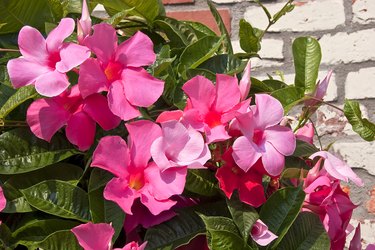
Mandevilla vines (Mandevilla spp.) produce bright trumpet-shaped flowers in a variety of colors. While the beautiful blooms may add a pop of color to your garden, they are considered mildly toxic if eaten either by people or pets.
Don't Eat Mandevilla Flowers
Video of the Day
Mandevilla vines grow in the warm climates of U.S. Department of Agriculture plant hardiness zones 9 through 11. The somewhat drought-tolerant vines are in the Apocynaceae, or dogbane, family. Members of the dogbane family are all toxic, in varying degrees, to people and animals. All parts of the vines, including the flowers, are considered mildly toxic if eaten. You might experience symptoms like mild indigestion if you eat mandevilla flowers.
Video of the Day
Handle Mandevilla Flowers with Caution
Mandevillas produce a milky sap containing an unknown toxin that can irritate your skin. You'll only encounter the sap when trimming the plant or if you bruise any parts of it, so wear gloves to avoid touching the sap. Stop the flow of this irritating latex sap with a powdered rooting hormone when replanting cuttings from a mandevilla, which will also encourage your new plants to flourish.
- North Carolina Cooperative Extension: Mandevilla spp.
- Florida Getting Started Garden Guide: Grow the Best Flowers, Shrubs, Trees, Vines & Groundcovers; Tom MacCubbin and Georgia B. Tasker
- Floridata: Mandevilla spp.
- The Tortoise Table: Mandevilla (Dipladenia, Brazilian Jasmine, Chilean Jasmine)
- University of Florida's Institute of Food and Agricultural Sciences: Mandevilla
- World Parrot Trust: Ask An Expert: Glenn Reynolds